member for the trees
  
Posts: 4003 Joined: 28-Jun-2011 Last visit: 27-May-2024
|
..thanks Dozuki, i'll work on finding a link/PDF..
i recall the phalaris-huasca affected one experimenter a lot more than the other..?
.
|
|
|
|
|

DMT-Nexus member
Posts: 1926 Joined: 10-May-2009 Last visit: 27-Apr-2015 Location: ☂
|
I think 5-MeO-DMT is the likely cause of "overdoses". It has very bad bodily effects in high doses, dysphoria and extreme head pressure, etc. With RIMAs this is especially bad, so bad it have lead to death. I would really like to see some evidence that tyramines have been found above trace quantities. Hordenine is a tyramine that has been found in up to 0.3% concentration in P. arundinacea, but it is metabolized by MAO-B, so shouldn't have bad interactions with RIMAs.
|
|
|

DMT-Nexus member

Posts: 14191 Joined: 19-Feb-2008 Last visit: 22-Nov-2025 Location: Jungle
|
|
|
|

Faustian Phytochem Investigator
 
Posts: 194 Joined: 31-Oct-2011 Last visit: 29-Nov-2025 Location: Oaxaca
|
@endlessness - Yes, I believe that to be the paper referenced above. @Ginko - It appears that this paper has some info on quantitative analysis of the tyramines. The abstract doesn't give numbers, but the paper has been interpreted here about 3/4 of the way down. It would be nice to see the full paper, but the table made from the data (lifted directly from the paper?) shows these compounds not only to be more than trace, but in some of the samples looked at they are in higher concentrations than the tryptamines.
|
|
|

DMT-Nexus member
Posts: 1926 Joined: 10-May-2009 Last visit: 27-Apr-2015 Location: ☂
|
Okay cool, seems like you indeed are correct that the tyramines may account for some bad interactions when attempting to make an Ayahuasca analog with certain species of Phalaris grass. Thanks for pushing me! It looks to me like Phalaris aquatica produces N-methyltyramine instead of the closely related compound hordenine, which Phalaris arundinacea produces, often in very high quantities. Both are stimulants, but the difference is that N-methyltyramine is metabolized by MAO-A, and will therefore be greatly potentiated by harmala-alkaloids, while hordenine is metabolized by MAO-B, and will not be potentiated. As Phalaris brachystachys is a very close relative to Phalaris aquatica, it can be assumed that N-methyltyramine is indeed present in that species too. In the Samorini (1994) paper where someone experienced an overdose, I agree that it may have been because of a bad interaction between N-methyltyramine and harmala-alkaloids. Maybe, or they just took too big a dose. Anyway, I've not found the article about tyramine content online, but the Drugs Forum article gives values for tryptamine concentrations, and the abstract says that levels of tyramines - with N-methyltyramine as the one with highest concentration - was always found in higher quantities than the tryptamine alkaloids. That means > 0.1% tyramines in Phalaris aquatica var. 'Australia', the one with the highest alkaloid concentration. Now, that is not very surprising, as hordenine is known from Phalaris arundinacea in concentrations up to 0.3%. To sum up, I think Phalaris aquatica produces N-methyltyramine + related tyramines instead of hordenine as seen in Phalaris arundinacea. This can be assumed to be the case with Phalaris brachystachys too. N-methyltyramine may be dangerous with harmala-alkaloids, while hordenine is not. The tyramines are all water-soluble and sparingly soluble in non-polar solvents. Oh, and thanks a lot for not believing me when I dismissed your theory! Good job! 
|
|
|

Faustian Phytochem Investigator
 
Posts: 194 Joined: 31-Oct-2011 Last visit: 29-Nov-2025 Location: Oaxaca
|
Glad we can see eye to eye on that one now  I think that it could account for 'toxic' like effects of P. aquatica with brews that are reported here and there. However, it still puzzles me about similar reports with P. arundinacea. I have not found any refs of tyramines being reported from that species, however, due to the way that most of the refs I have do the extractions, they would exclude these tyramines as they stay in the aqueous portions of the extractions and don't go into the solvents (they are zwitterionic and stay in both the acid and base solutions). This is why there are more recent articles proposing new methods to include the tyramines in the studies. The older ones missed them. *If* P. arundinacea did in fact produce the tyramines (other than hordenine) this could totally explain Johnny Appleseed's need to simmer for only 15 minutes as well as explain why he never succeeded in "isolating the toxicity" and breeding it out. A little TLC could suss this out pretty easily. The fact that both species produce hordenine is at least a clue to the possibility that P. arundinacea *might* also produce tyramines.
|
|
|

analytical chemist
   
Posts: 7463 Joined: 21-May-2008 Last visit: 09-Aug-2025 Location: the lab
|
Dozuki wrote:they are zwitterionic and stay in both the acid and base solutions this statement is incomplete. molecules are only zwitterionic at their pI; above and below that point, they will incur charge states. psilocybin is a prime example, it's only zwitterionic at pH 4, and has five possible charge states across the pH scale "Nothing is true, everything is permitted." ~ hassan i sabbah
"Experiments are the only means of attaining knowledge at our disposal. The rest is poetry, imagination." -Max Planck
|
|
|

DMT-Nexus member
 
Posts: 12340 Joined: 12-Nov-2008 Last visit: 02-Apr-2023 Location: pacific
|
benzyme wrote:i've been saying that for the past two years.
I guess people would still rather invest in rootbark than a chromatography column
and some silica. Have you done this yet? You definatily have the skills to do this sort of thing and I would love to see the results. I know the alkaloids we want are in there..I have tested extracts from wild grass on myself and it is worth figuring out how to extract the stuff. All my experiments have confirmed to me the molecules are in there, they just need to be seperated from the other alkaloids. I am personally not concerned with removing 5meoDMT..DMT/5meo in ratio is fine by me..but I would still be interested in the results of people who are into seperation. I just started an extraction of a big pot of grass I gathered a few hours ago from a spot not to far off into the woods where I collected the stuff gave me the most potent extract that one winter..there has been some frost now and the grass is still green in some parts and yellow in others-stressed..which means high alk content. Long live the unwoke.
|
|
|

analytical chemist
   
Posts: 7463 Joined: 21-May-2008 Last visit: 09-Aug-2025 Location: the lab
|
i need the grass. the ideal solvent mix would be chloroform:methanol:water 50:40:30, i think. i'll have to doublecheck the chrom handbook. i may have mentioned, the extraction may be treated with ehrlich's reagent (which is very acidic), then eluted through the column with the aformentioned tertiary mobile phase, for better visualization. would definitely look cool under UV either ehrlich's or mandelin reagent would characterize hordenine, gramine, and 5-MeO. "Nothing is true, everything is permitted." ~ hassan i sabbah
"Experiments are the only means of attaining knowledge at our disposal. The rest is poetry, imagination." -Max Planck
|
|
|

analytical chemist
   
Posts: 7463 Joined: 21-May-2008 Last visit: 09-Aug-2025 Location: the lab
|
a process which adsorbs a quaternary alkylammonium surfactant onto silica, creating an anion exchange resin, is as follows Quote:Cleaned silica gel (100 g) was soaked in 250 ml of di-
chloromethane containing a weighed amount of Adogen
464. The mixture was stirred mechanically for 3 hr and
then the solvent was evaporated under reduced pressure at
room temperature and the air-dried product was stored in
a bottle.
i'll need to look back at some ebooks, but i think the sample dissolved in dilute ammonia (pH 8 - 9) eluted with two different concentrations of NaCl should be able to separate the compounds nicely on this stationary phase "Nothing is true, everything is permitted." ~ hassan i sabbah
"Experiments are the only means of attaining knowledge at our disposal. The rest is poetry, imagination." -Max Planck
|
|
|
member for the trees
  
Posts: 4003 Joined: 28-Jun-2011 Last visit: 27-May-2024
|
..thanks benzyme, endlessness posted Trout saying: Quote:More recent work strongly suggests that one or more, up to several novel furanobisindoles may be involved in the toxicity. Several have been characterized.
See the recent published accounts by N. Anderton, C.A. Bourke, S.M. Colegate and R. Oram for more
details concerning their research ..this doesn't sound like a dead end...
|
|
|

Faustian Phytochem Investigator
 
Posts: 194 Joined: 31-Oct-2011 Last visit: 29-Nov-2025 Location: Oaxaca
|
benzyme wrote:this statement is incomplete zwitterionic and high water solubility across a broad pH range...
|
|
|

analytical chemist
   
Posts: 7463 Joined: 21-May-2008 Last visit: 09-Aug-2025 Location: the lab
|
tyramine's charge distribution  I'll generate the graph for n-methyltyramine and upload it "Nothing is true, everything is permitted." ~ hassan i sabbah
"Experiments are the only means of attaining knowledge at our disposal. The rest is poetry, imagination." -Max Planck
|
|
|

analytical chemist
   
Posts: 7463 Joined: 21-May-2008 Last visit: 09-Aug-2025 Location: the lab
|
zwitterionic species is 4, and no charge is 1 (red and orange). as you can see, they max at pH 10.2, and are not relatively abundant. benzyme attached the following image(s):  Untitled.png (64kb) downloaded 908 time(s)."Nothing is true, everything is permitted." ~ hassan i sabbah
"Experiments are the only means of attaining knowledge at our disposal. The rest is poetry, imagination." -Max Planck
|
|
|

DMT-Nexus member
Posts: 83 Joined: 13-May-2011 Last visit: 24-May-2020 Location: CBus
|
Here's that link I mentioned: http://www.dmtextraction...laris2dmtextraction.htm
Any thoughts on the idea you can juice the grass with a wheat grass type juicer, evaporate the juice to powder then smoke?
|
|
|

DMT-Nexus member

Posts: 14191 Joined: 19-Feb-2008 Last visit: 22-Nov-2025 Location: Jungle
|
Dont do this, as it has been mentioned in this thread already, unless you have analysed that particular juice to know there isnt gramine or other potentially toxic alkaloids. Also, independent of other alkaloids content, you should always freebase alkaloids before smoking them, not smoking the natural salt forms.
Wheat grass juicer is probably a good idea as a first step in an extraction, but then you should base and pull with a non-polar, ideally hexane/heptane/naphtha, to try to eliminate gramine.
Start very low with any phalaris bioassay! Ideally in the long run you'd want to get into TLC and colorimetric reagents to be safer and know what you're yielding. Check the substance testing/analysis subforum here in the nexus for more info on how it all works.
|
|
|

DMT-Nexus member
Posts: 83 Joined: 13-May-2011 Last visit: 24-May-2020 Location: CBus
|
So ideally, juice said grass, maybe Big Medicine?
Then with juice perform an STB, freeze precipitation after possible? Even after a couple re-x's would this product still be too toxic?
Of course a full analysis would be best, but I am so interested in sustainability and this seems possible if albeit problematic at the moment.
I know the stuff produced from the beginning of this thread seemed no good; was this because it was an A/B process? Does an STB allow the spirit molecule ONLY to migrate into the NP solvent or will other alks, different from MHRB, also get into the solvent? I.E. how toxic could this process be potentially for the end product?
Much thanks to everyone who is a part of this thread!
Besides 'Big Medicine', what are the best types of Phalaris for this?
|
|
|

Faustian Phytochem Investigator
 
Posts: 194 Joined: 31-Oct-2011 Last visit: 29-Nov-2025 Location: Oaxaca
|
For Grasses an A/B extraction would be the better option. If you did a (an) STB on grass you will end up with the oils, lipids and other things in the non-polar layer and I suspect this would have an effect on freeze precipitation. An A/B extraction gets rid of these during the de-fat (the A portion).
Theoretically, freeze precipitation should leave behind any gramine, hordinine and tyramines as they are not soluble in petroleum ether. (The Merck Index says 'practically insoluble' for gramine and hordenine, but gives no quantities.)
-D.
|
|
|
member for the trees
  
Posts: 4003 Joined: 28-Jun-2011 Last visit: 27-May-2024
|
smri wrote: Quote:Besides 'Big Medicine', what are the best types of Phalaris for this? ..as others mentioned earlier the Italian 'AQ1' strain (of, i believe, Phalaris aquatica) standing for 'alkaloid quotient one'..i.e 1% of dry weight..despite finding mainly DMT, this was the strain that was unpredictably potent in an ayahuasca analogue..strains should be propagated by root division to ensure continuation of genetic profile...
|
|
|

DMT-Nexus member

Posts: 14191 Joined: 19-Feb-2008 Last visit: 22-Nov-2025 Location: Jungle
|
These are the alkaloids found in phalaris (aquatica and arundinacea, dont know if brachystachys has other alks) till now, according to festi and samorini 1994:N-methyltryptamine (MMT or NMT)  5-methoxy-N-methyltryptamine 5-methoxy-N-methyltryptamine (5-MeO-MMT or NMT) 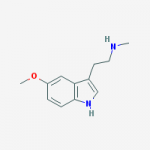 N,N-dimethyltryptamine N,N-dimethyltryptamine (DMT) 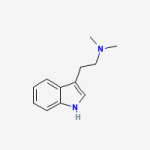 5-methoxy-N,N-dimethyltryptamine 5-methoxy-N,N-dimethyltryptamine (5-MeO-DMT)  5-hydroxy-N,N-dimethyltryptamine 5-hydroxy-N,N-dimethyltryptamine (Bufotenine, 5-HO-DMT) 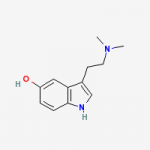 5-methyl-tryptamine  5-methoxy-tryptamine 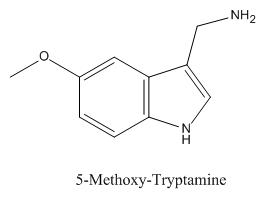 2-methyl-l,2,3,4-tetrahydro-B-carboline 2-methyl-l,2,3,4-tetrahydro-B-carboline (MTHC or or rather 2MTHBC), not found in P. aquatica  2-methyl-6-methoxy-1,2,3,4-tetrahydro-B-carboline (MMTHC) 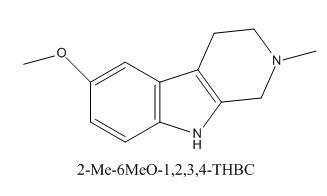 2,9-dimethyl-6-methoxy-l ,2,3,4-tetrahydro-B-carboline (DMTHC) 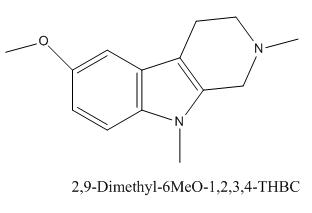 Gramine 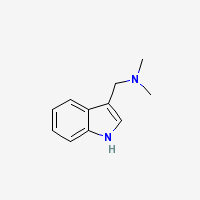 7-methoxy-gramine 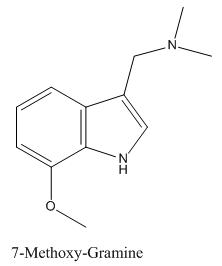 5,7-dimethoxy-gramine 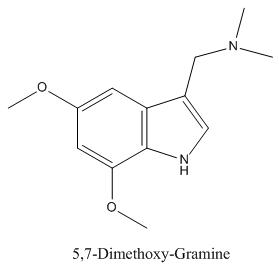 Hordenine Hordenine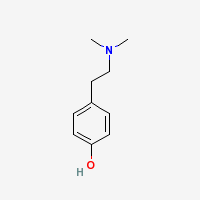 So what do we know about about those 2 gramine analogues (7 methoxy and 5,7 dimethoxy)? What about the beta carbolines (2-Methyl-6-Methoxy, and the 2,9-dimethyl-6-methoxy)? Would be interesting to have solubilities, colorimetric reagent data, Rf data, pharmacology, or generally anything we can know about these alkaloids. Also more info on 5-methyl-tryptamine and 5-methoxy-tryptamine Dozuki just posted some TLC analysis of wild phalaris here. Regarding 2-methyl-6-methoxy-1,2,3,4-tetrahydro-B-carboline, we also need more info, but we have some preliminary chemical info on Dozuki's thread above, as well as in the Gander et al 1976 publication. This Gander publication has MS spectra and some TLC info. 2-Methyl-6-MeO-THBC turns turns Blue-Violet with Xanthydrol, Rf is 0.47 On paper in n-BuOH(HOAc-H20 (80:3:17). This info will be added to the colorimetric test (marquis, mecke, ehrlich, etc) results thread, and to the Rf thread/excel file. I would think that neither the beta carbolines and neither the gramines and their analogues will be soluble in naphtha/hexane/heptane, but more tests are def necessary to be sure. The next info I'd like to add about phalaris is the recent GC-MS done in AQ1 and Yugo red (Big Medicine coming soon, maybe later today). Identification of all the peaks still pending, but AQ1 has DMT, no 5-MeO, no gramine. I'll check for the other alkaloids mentioned here as soon as I find their MS spectra data. Yugo red has only traces of DMT and a very significant amount of gramine. The peaks are being identified, the work thread with the raw GC-MS data is here, once more stuff is identified, this will be added to this phalaris thread, as well as to the Nexian-based plant/substance analysis results thread
|